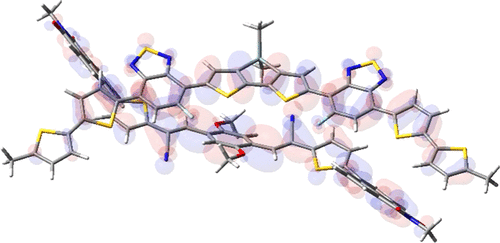当前位置:
X-MOL 学术
›
J. Phys. Chem. A
›
论文详情
Our official English website, www.x-mol.net, welcomes your feedback! (Note: you will need to create a separate account there.)
A Projective Method for the Calculation of Excited-State Electronic Coupling: Isolating Charge Transfer/Recombination Processes in Organic Photovoltaics.
The Journal of Physical Chemistry A ( IF 2.9 ) Pub Date : 2020-01-13 , DOI: 10.1021/acs.jpca.9b10167 Paul A Hume 1, 2 , Justin M Hodgkiss 1, 2
The Journal of Physical Chemistry A ( IF 2.9 ) Pub Date : 2020-01-13 , DOI: 10.1021/acs.jpca.9b10167 Paul A Hume 1, 2 , Justin M Hodgkiss 1, 2
Affiliation

|
Electronic coupling between excited states is a vital parameter required to describe ultrafast energy and charge transfer processes that occur in photoresponsive organic materials. In such systems, short-range Coulombic, exchange, overlap, and configuration interaction effects must all be accounted for. Although a number of methods are available, the evaluation of coupling between arbitrary excited states remains challenging. In this contribution, a flexible and scalable method for the calculation of short-range electronic coupling between excited states is developed. Excitation- or charge-localized states are projected onto the adiabatic states of a dimeric molecular system using an efficient wave function overlap algorithm. In addition to correctly treating Coulombic, exchange, and overlap contributions, the inclusion of multistate interactions is inherent in the procedure. The method is then used to disentangle excitation energy transfer, charge transfer, and charge recombination processes in donor/acceptor systems relevant to organic photovoltaics, with a view toward the development of material design principles. Calculations were performed within single-excitation frameworks, but the scheme has the potential to be extended to multireference/higher-order excitation quantum-chemical methods.
中文翻译:

一种计算激发态电子耦合的投影方法:隔离有机光伏中的电荷转移/复合过程。
激发态之间的电子耦合是描述在光响应有机材料中发生的超快能量和电荷转移过程所必需的重要参数。在这样的系统中,必须考虑短距离库仑,交换,重叠和构型相互作用的影响。尽管有许多方法可用,但是评估任意激发态之间的耦合仍然具有挑战性。在此贡献中,开发了一种灵活且可扩展的方法来计算激发态之间的短程电子耦合。使用有效的波函数重叠算法,将激发态或电荷局部化状态投影到二聚体分子系统的绝热状态上。除了正确处理库仑的,交换的和重叠的贡献外,程序中固有包含多状态交互。然后,该方法用于解决与有机光伏相关的供体/受体系统中的激发能转移,电荷转移和电荷复合过程,以期发展材料设计原理。计算是在单激发框架内进行的,但该方案有可能扩展到多参考/高阶激发量子化学方法。
更新日期:2020-01-14
中文翻译:

一种计算激发态电子耦合的投影方法:隔离有机光伏中的电荷转移/复合过程。
激发态之间的电子耦合是描述在光响应有机材料中发生的超快能量和电荷转移过程所必需的重要参数。在这样的系统中,必须考虑短距离库仑,交换,重叠和构型相互作用的影响。尽管有许多方法可用,但是评估任意激发态之间的耦合仍然具有挑战性。在此贡献中,开发了一种灵活且可扩展的方法来计算激发态之间的短程电子耦合。使用有效的波函数重叠算法,将激发态或电荷局部化状态投影到二聚体分子系统的绝热状态上。除了正确处理库仑的,交换的和重叠的贡献外,程序中固有包含多状态交互。然后,该方法用于解决与有机光伏相关的供体/受体系统中的激发能转移,电荷转移和电荷复合过程,以期发展材料设计原理。计算是在单激发框架内进行的,但该方案有可能扩展到多参考/高阶激发量子化学方法。


























 京公网安备 11010802027423号
京公网安备 11010802027423号